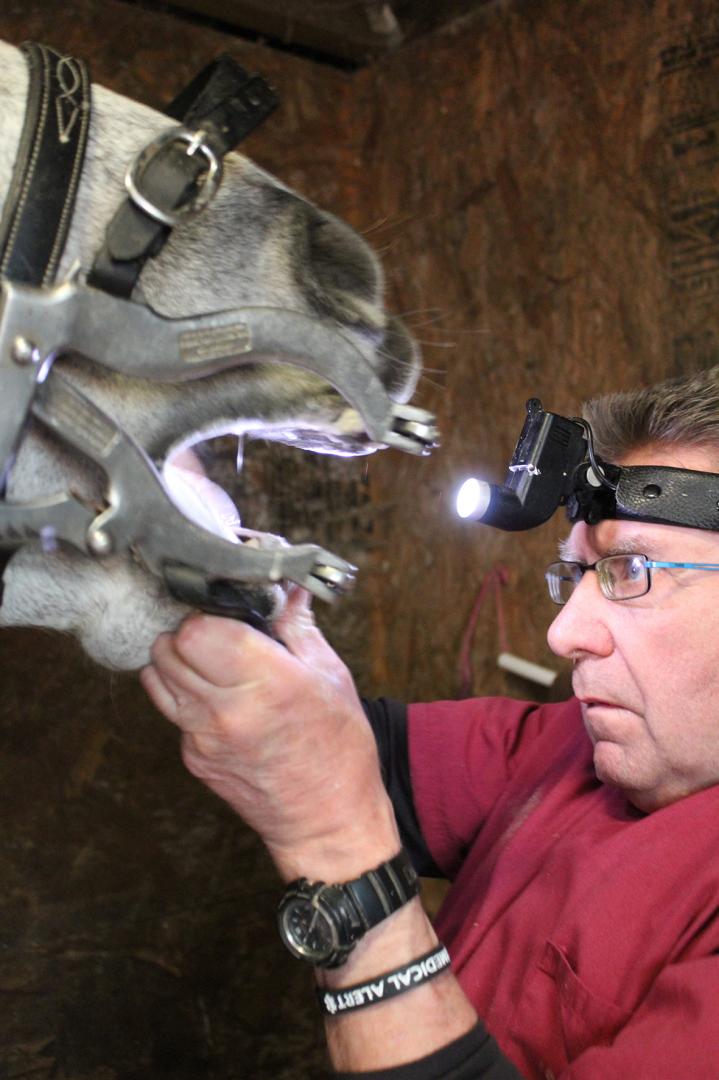Equine dentistry is an ancient skill and one which is essential for the wellbeing of a healthy horse or pony. Reporter Wendy Short went to meet practitioner Kevin Hallett
EQUINE dentist Kevin Hallett’s first patient of the day is Maggie, a grey show jumping pony.
She stands quietly while he inspects her teeth and goes on to reduce the sharp points and ridges so that she can eat comfortably and perform to her best. Maggie has historically received her dental check-up on an annual basis, but he has recommended that the procedure is carried out more frequently.
“An annual treatment will be adequate for most horses, but Maggie’s temporal mandibular joint is quite tight and she has a small chewing circle,” says Mr Hallett. “Therefore I have suggested that she has her teeth examined twice a year to make sure that she is not in any discomfort.
“Once a horse reaches about 18, the enamel on its teeth can become softer and it may not require corrective work as frequently, although the teeth should continue to be monitored on a regular basis as they can become loose and require extraction. Horses can also suffer from abscesses and fractures.”
It is worth noting that a horse can look perfectly fit and healthy but can be experiencing severe pain in its mouth, he adds.
Head tossing, problems with bit acceptance and rearing are some of the most well-known signs of poor dental health, but others include discharge from the eye, nose or jaw, becoming head shy, not eating or avoiding hay and quidding.
“Conformational changes can also occur and if you were to draw a line through the mid-forelock and across the top of the eyes you will be able to locate the two temporal muscles, which should be smooth and symmetrical,” he says. “If the muscles are unequal in size it may indicate that your horse is not chewing correctly on both sides. Another way to test for issues is to gently palpate the cheek against the teeth, to see whether the horse shows any signs of pain or discomfort.
“I also see a lot of damage caused by incorrect bitting and the rule that the bit should leave two wrinkles at the corner of the mouth does not apply to every horse or pony. We need to consider the length of the lips, thickness of tongue and the shape of the palatine arch, which is the roof of the mouth where the bit lies.
“Wolf teeth can sometimes create discomfort but they do not always need to be removed, unless they interfere with the bit or are causing discomfort. A qualified equine dentist can extract wolf teeth as long as a vet is present, but blind wolf teeth are the exception, as their removal is classed as an act of surgery and must be performed by a vet.”
Mr Hallett’s next subject is Hector, a top show jumping horse which is stabled alongside Maggie at West Auckland. Hector is generally not quite as relaxed as Maggie about his dental work he always receives a vet-prescribed oral sedative and it is given time to take effect before treatment begins. This measure is enough to keep Hector standing quietly for his session.
It is 15 years since Mr Hallett retired from his career as a sergeant major in the army and became a horse dentist. He has owned horses in the past and competed in show jumping, worked as a wrangler on ranches in Canada and jousted with the Knights of Middle England.
His second career began after a chance meeting.
“I was on leave from the Army and was helping manage a livery yard for a friend when I happened to be there when the horse dentist visited. I had been wondering what I would do after my retirement and was fascinated by his work.
He suggested that I travel to the USA if I wanted to start equine dentistry as a new career, as the country is renowned for having high standards in equine dentistry.
“I subsequently visited the USA several times, where I completed a number of courses and worked with certified equine dentists. However I had to undertake further training in the UK, because the American qualifications are not recognised here. I still fly to the USA on a yearly basis as an instructor and I also attend continuing professional development courses.
“I am a qualified equine dentist with the International Association of Equine Dentists and the Worldwide Association of Equine Dentists, which is recognised by Defra, as well as being a certified bitting analyst.”
Asked why the USA holds its position as one of the top countries in which to learn equine dentistry, he has a ready answer.
“Equine dentistry has been performed in the UK and in the USA for about 150 years and the speculum I use on the horses to check the teeth safely was designed in 1908 by John Hausman of London. After the First World War technology took a huge leap forward and much of the work carried out by horses was replaced by motorised equipment. In the USA, however, horses continue to be used on many farm and ranches, so equine dentistry did not go into decline as it did in the UK.”






